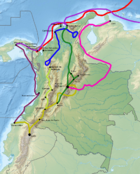Juan Tafur
- N.N, Antonia Manuel de Hoyos
- Francisca de Ulloa
- Juan Pérez Tubera (father)
- Isabel Díaz Tafur (mother)
Martín Yañéz Tafur
Hernán Venegas Carrillo
Pedro Fernández de Valenzuela
1541–1541
1546–1547
1552–1552
1554–1554
1559–1559
Juan Tafur (1500, Córdoba, Andalusia, Castile - ?, ?) was a Spanish conquistador who participated in the Spanish conquest of the Muisca people. He was a cousin of fellow conquistadors Martín Yañéz Tafur, Hernán Venegas Carrillo and Pedro Fernández de Valenzuela. Juan Tafur was five times encomendero (mayor) of Santa Fe de Bogotá. He also received the encomiendas of Pasca, Chipaque and Usaquén. The encomienda of Suesca was shared between Tafur and Gonzalo García Zorro.
Knowledge of the life of Juan Tafur has been provided by the work El Carnero (1638), by chronicler Juan Rodríguez Freyle.
Biography
Family
Juan Tafur was born in the year 1500 in Córdoba, Spain. His parents were Juan Pérez Tubera and Isabel Díaz Tafur. Tafur took the surname of his mother.[1] Other family members were also conquistadors: Pedro Fernández de Valenzuela, Hernán Venegas Carrillo and Martín Yañés Tafur.[3]
American expeditions
In 1518 he left Spain for the New World under the command of Pedro de los Ríos, governor of Tierra Firme in Panama. De los Ríos sent Tafur with two ships to retrieve the dissatisfied members of the Pizarro expedition. In 1531 or 1533, Tafur left for Santa Marta, where he was sent to the Valle de Upar, together with conquistadors Antonio de Lebrija, Juan de Sanct Martín, Juan Muñoz de Collantes and Juan de Céspedes to force the submission the Chimila people to the Spanish.[4]
In April 1536, Tafur was appointed cavalry leader in the expedition led by Gonzalo Jiménez de Quesada[5] which left the Caribbean city of Santa Marta in search of El Dorado.[6] Tafur participated in the Spanish conquest of the Muisca people and received the encomiendas of Pasca, Usaque, Itaque and Chipaque, where he built the first church in 1538.[7][2] The encomienda of Suesca was shared between Juan Tafur and Gonzalo García Zorro.[8]
Mayoralties
Juan Tafur was five times encomendero of Santa Fe de Bogotá: in 1541 succeeding Antonio Díaz de Cardoso and preceding Juan Díaz Hidalgo; from 1546 to 1547 succeeding Juan de Céspedes and succeeded by Pedro de Colmenares; in 1552 between the reigns of Juan Muñoz de Collantes and Gonzalo Rodríguez de Ledesma; in 1554 succeeding Gonzalo García Zorro and before Juan Ruiz de Orejuela; and finally in 1559 after the rule of Gonzalo Rodríguez de Ledesma and preceding Antonio Bermúdez.[9] In 1552, he requested 72 emeralds from Diego de Aguilar.[10]
Mistreatment of native Americans
He committed various atrocities against the indigenous people, including against the Panche people to the west of the Bogotá savanna. He mistreated the Cacique (leader) of Pasca and the Cacique of Chita, whose body he threw at the dogs.[11] In 1543, he was convicted for the mistreatment of the indigenous Muisca of Pasca.[10]
Personal life
Juan Tafur was married three times: to an unnamed woman; to Antonia Manuel de Hoyos; and to Francisca de Ulloa. He had a daughter named Isabel Tafur.[1]
Encomiendas







See also
- List of conquistadors in Colombia
- Spanish conquest of the Muisca
- Hernán Pérez de Quesada, Juan de Céspedes
- Gonzalo Jiménez de Quesada
References
- ^ a b c Juan Tafur - Geni
- ^ a b (in Spanish) Juan Tafur - Banco de la República - Soledad Acosta de Samper
- ^ Rodríguez Freyle, 1638, p.62
- ^ Rodríguez Freyle, 1638, p.66
- ^ Acosta, 1848, p.400
- ^ (in Spanish) Lista de los que consiguieron el descubrimiento del Reino de Granada con el General don Gonzalo Jiménez de Quesada, en el año de 1538 Archived 2016-03-09 at the Wayback Machine - Banco de la República
- ^ (in Spanish) Official website Chipaque Archived 2014-03-10 at archive.today
- ^ Rodríguez Freyle, 1638, p.112
- ^ (in Spanish) List of mayors of Bogotá - 1538-1599
- ^ a b (in Spanish) Los caballeros de la conquista
- ^ Rodríguez Freyle, 1638, p.67
Bibliography
- Acosta, Joaquín. 1848. Compendio histórico del descubrimiento y colonización de la Nueva Granada en el siglo décimo sexto - Historical overview of discovery and colonization of New Granada in the sixteenth century, 1-460. Beau Press. Accessed 2017-03-06.
- Rodríguez Freyle, Juan, and Darío Achury Valenzuela. 1979 (1859) (1638). El Carnero - Conquista i descubrimiento del nuevo reino de Granada de las Indias Occidentales del mar oceano, i fundacion de la ciudad de Santa Fe de Bogota, 1-592. Fundacion Biblioteca Ayacuch. Accessed 2017-03-06.
Further reading
- De Castellanos, Juan. 1857 (1589). Elegías de varones ilustres de Indias, 1–567. Accessed 2017-03-01.
- Fernández de Piedrahita, Lucas. 1676. VI. Historia general de las conquistas del Nuevo Reino de Granada. Accessed 2017-03-01.
- Jiménez de Quesada, Gonzalo. 1576. Memoria de los descubridores, que entraron conmigo a descubrir y conquistar el Reino de Granada. Accessed 2017-03-01.
- Ocampo López, Javier. 1996. Leyendas populares colombianas - Popular Colombian legends, 1-384. Plaza y Janes Editores. Accessed 2017-03-01.
- De Plaza, José Antonio. 1810. Memorias para la historia de la Nueva Granada desde su descubrimiento el 20 de julio de 1810, 1-464. Imprenta del Neo-Granadino. Accessed 2017-03-01.
- Simón, Pedro. 1892 (1626). Noticias historiales de las conquistas de Tierra Firme en las Indias occidentales (1882-92) vol.1-5. Accessed 2017-03-01.
- N, N. 1979 (1889) (1539). Epítome de la conquista del Nuevo Reino de Granada, 81-97. Banco de la República. Accessed 2017-03-01.
- v
- t
- e
Topics | |||||||
|---|---|---|---|---|---|---|---|
| |||||||
Geography and history | |||||||||||||
|---|---|---|---|---|---|---|---|---|---|---|---|---|---|
| |||||||||||||
Religion and mythology | |||||||||||||||
|---|---|---|---|---|---|---|---|---|---|---|---|---|---|---|---|
| |||||||||||||||
Caciques and neighbours | |||||||||||||||||||||||
|---|---|---|---|---|---|---|---|---|---|---|---|---|---|---|---|---|---|---|---|---|---|---|---|
| |||||||||||||||||||||||
| ||||||||||
Research and collections | |||||||||
|---|---|---|---|---|---|---|---|---|---|
| |||||||||
 Category
Category

















